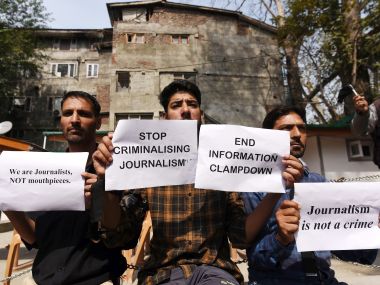How does one gauge the response of a people to a government move if the functioning of the fourth estate, which is supposed to remain representative of the voices of the people, is hampered? The 5 August announcement to abrogate Article 370 and downgrade Jammu and Kashmir into Union Territories came with massive curbs — all of Kashmir was shutdown with huge deployment of the armed forces along with a 100 percent clampdown on communications — no landlines, no mobile services, no internet. While we had reports coming from Ladakh and Jammu about responses of people, there were none from Kashmir. [caption id=“attachment_7496631” align=“alignleft” width=“380”] Local journalists organised a protest on 3 October against the communication blockade. Getty Images[/caption] For the longest time, nobody knew what was happening in Kashmir. Families outside of Kashmir couldn’t contact people, within Kashmir people couldn’t contact each other. Local journalists had no way of updating their websites or even sending reports to Indian or international media agencies. For close to three weeks, Kashmiri journalists had to send information through pen drives to Delhi. Several reports detailed how journalists were stopped from accessing parts of Kashmir and were being harmed when they started to report. Reports from Kashmir were disparate, even. Many Indian news channels started carrying reports claiming normalcy in Valley while international agencies like BBC and the New York Times reported on unrest, protests and mayhem in Kashmir. All this while most local journalists continued to remain cut off. Journalists organised a protest on 3 October, urging the government to revoke the communication blockade and restore access to mobile and internet services. The government had announced that it will restore access to postpaid mobile services on Saturday, which was later pushed to Monday (14 October). Firstpost speaks to Quratulain Rehbar and Mansoor Peer to understand the difficulties that journalists have been facing while reporting in Valley since 5 August.
The 5 August announcement to abrogate Article 370 and downgrade Jammu and Kashmir into Union Territories came with massive curbs — all of Kashmir was shutdown with huge deployment of the armed forces along with a 100 percent clampdown on communications — no landlines, no mobile services, no internet.
Advertisement
End of Article


)

)
)
)
)
)
)
)
)



